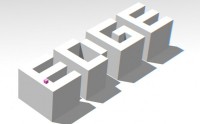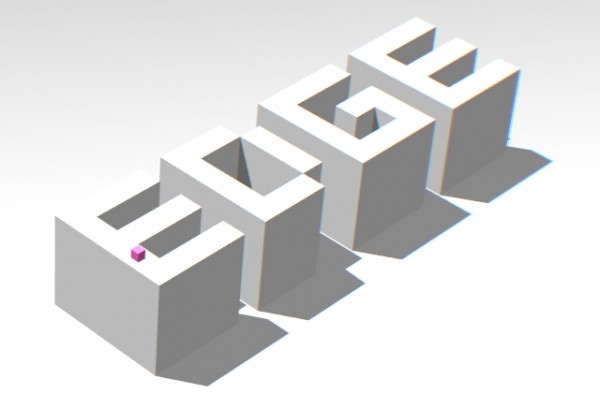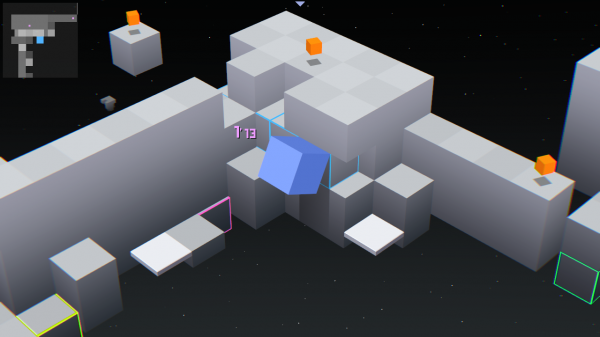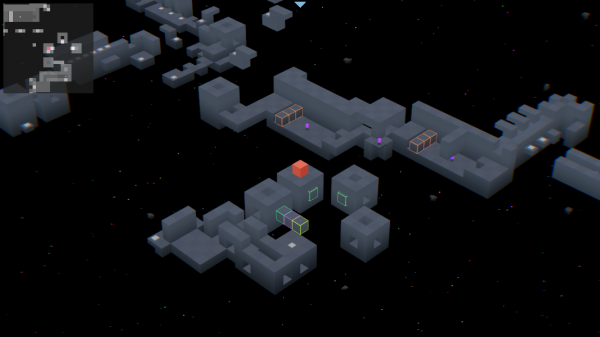After all the legal disputes over EDGE’s name, I for one am glad to have the opportunity to play it on the PC now. EDGE has this inherent charm in the sense that whenever you fire it up on Steam, your humorous friends will flood the screen yelling “EDGE” in all caps. It also inspires the same in the player: whenever someone is legitimately interested in the game and asks you about it, you just yell “it’s OVER THE EDGE”.
But beneath all this potential for C-grade Internet jokes, we are introduced to a very fun game. You play as a psychedelic epilepsy-inducing cube with nothing to lose, and make your way through the sharp-edged monochrome version of Kula World (that’s Roll Away for you Americans). While flipping your way through the stages, you need to avoid gaps and getting crushed, and possibly collect all the prisms as your secondary objective.
At first, the isometric view with the fixed angle might seem intimidating, but the player is supplied with a small map in the upper left corner which is, in most cases, essential if you want to collect all the shinies. After I had realized the importance of the map, the game became a lot easier.
While EDGE is classified as a puzzle game, it challenges your wits far less than your actual reflexes. There are only a handful of moments where I had to sit down and plan my route. Most “unreachable” prisms boiled down to finding the odd platform on the map, doing a leap of faith and getting transported to the hidden shiny.
That’s one of the interesting things of the level design, actually: a lot of is automated. Not in the “you sit down and watch an unskippable scripted event for eons” way. The longest “transport across the map” sequence I had witnessed was maybe ten seconds long. I found some levels used this approach more than they should have, but never enough to make me shout “Let me play!” like games such as Devil May Cry do.
As mentioned before, the challenges are reflex-based, with the center of attention being “EDGE time”. You are able to stick to walls and moving platforms by balancing your cube. This is vital to master, as many gaps are only surmountable by using the EDGE mechanic.
The music is also excellent and ranges from soothing and lonely to upbeat and happy, all wrapped up in glorious 8-bit. You can even download it free of charge.
There is one issue with the actual gameplay, though. Your cube is bound to an invisible grid (usually), but plenty of moving platforms aren’t. This can lead to you landing on a moving platform which has continued moving on without your cube, causing you to fall off.
All in all, EDGE offers plenty of levels and bonus levels for its price, as well as free DLC with an additional 40 levels incoming. If you’re a fan of puzzle platformers, we recommend giving the demo a shot and see if EDGE is to your liking. It gives a good idea of what the rest of the game plays like.
Platform: PC, Mac
Developer: Mobigames (original), Two Tribes (PC and Mac)
Genre: Puzzle platformer
Time: 4 hours
Gripes: Falling off moving platforms
Get it for the: Fun, edgy gameplay and plenty of content for price.
Full disclosure: PXOD was given a PC review copy of the game from the developer. The normal levels were played to 100% completion, while only a few bonus levels were played.



